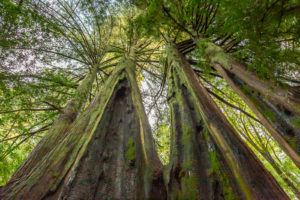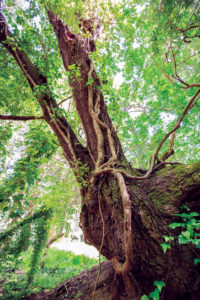The Marin County Board of Supervisors approved a new ordinance on Wednesday that further restricts tree-cutting, although salmon advocates say it doesn’t go far enough.
Before the new ordinance passed, residents could cut down up to five trees of any kind, whether they were native or not, ancient or young, each year without a permit. The Marin supervisors voted to restrict that number to two trees and protect “heritage trees” — very large, old, native trees — from being cut down without a permit. But the ordinance provides no restrictions for what are referred to as “protected” trees, which are mature trees that are not tall enough to pass as heritage.
Todd Steiner, Executive Director of SPAWN (the Salmon Protection and Watershed Network), said Marin could become virtually treeless over time if it doesn’t protect mature trees.
“It’s a failure of land use planning, it’s a failure to enforce resource management, and it’s a total failure of leadership by the county supervisors to do what’s right for the environment,” said Steiner.
He said the county needs to make sure that new trees replace those that are cut down, and it should close the loopholes that allow the cutting of any kind of tree.
Marin Supervisor Steve Kinsey acknowledged the importance of native trees to the health of riparian areas, but also said that in order to be effective, the development plan had to be both affordable and enforceable. The county already faces budget challenges, he added.
“It would be unreasonably expensive and time consuming to seek a permit for every single tree in this county that needs to be brought down,” Kinsey said during the meeting. “We can always come back.”
The Board also approved exemptions to needing a permit for diseased trees and those that pose a health, safety, or fire protection concern.
Trees play a valuable role in soil regeneration, producing clean air and water, slowing the process of global warming, and providing moisture that potentially acts as a buffer during fires. But it’s their positive impact on salmon habitat that SPAWN is chiefly concerned with protecting.
Trees provide shade that keeps creeks cool, crucial to salmon survival. They also act as buffers from sedimentation and chemical pollutants. Roots that grow into the creek, as well as trees that die and fall into the creek, provide useful habitat for salmon. Fog drip can also be important to maintaining stream flows. Steiner said trees are in a complex relationship with their habitats.
“When you have a stand of trees, you think cutting out the one in the middle to let in more sun isn’t going to make a difference,” said Steiner. “But those trees are all interacting with each other. The tree on the outside is helping to protect the tree on the inside. If you cut one down, you don’t know what the impact will be.”
Before the new ordinance passed, residents could cut down up to five trees of any kind, whether they were native or not, ancient or young, each year without a permit. The Marin supervisors voted to restrict that number to two trees and protect “heritage trees” — very large, old, native trees — from being cut down without a permit. But the ordinance provides no restrictions for what are referred to as “protected” trees, which are mature trees that are not tall enough to pass as heritage.
Todd Steiner, Executive Director of SPAWN (the Salmon Protection and Watershed Network), said Marin could become virtually treeless over time if it doesn’t protect mature trees.
“It’s a failure of land use planning, it’s a failure to enforce resource management, and it’s a total failure of leadership by the county supervisors to do what’s right for the environment,” said Steiner.
He said the county needs to make sure that new trees replace those that are cut down, and it should close the loopholes that allow the cutting of any kind of tree.
Marin Supervisor Steve Kinsey acknowledged the importance of native trees to the health of riparian areas, but also said that in order to be effective, the development plan had to be both affordable and enforceable. The county already faces budget challenges, he added.
“It would be unreasonably expensive and time consuming to seek a permit for every single tree in this county that needs to be brought down,” Kinsey said during the meeting. “We can always come back.”
The Board also approved exemptions to needing a permit for diseased trees and those that pose a health, safety, or fire protection concern.
Trees play a valuable role in soil regeneration, producing clean air and water, slowing the process of global warming, and providing moisture that potentially acts as a buffer during fires. But it’s their positive impact on salmon habitat that SPAWN is chiefly concerned with protecting.
Trees provide shade that keeps creeks cool, crucial to salmon survival. They also act as buffers from sedimentation and chemical pollutants. Roots that grow into the creek, as well as trees that die and fall into the creek, provide useful habitat for salmon. Fog drip can also be important to maintaining stream flows. Steiner said trees are in a complex relationship with their habitats.
“When you have a stand of trees, you think cutting out the one in the middle to let in more sun isn’t going to make a difference,” said Steiner. “But those trees are all interacting with each other. The tree on the outside is helping to protect the tree on the inside. If you cut one down, you don’t know what the impact will be.”

.jpg)



